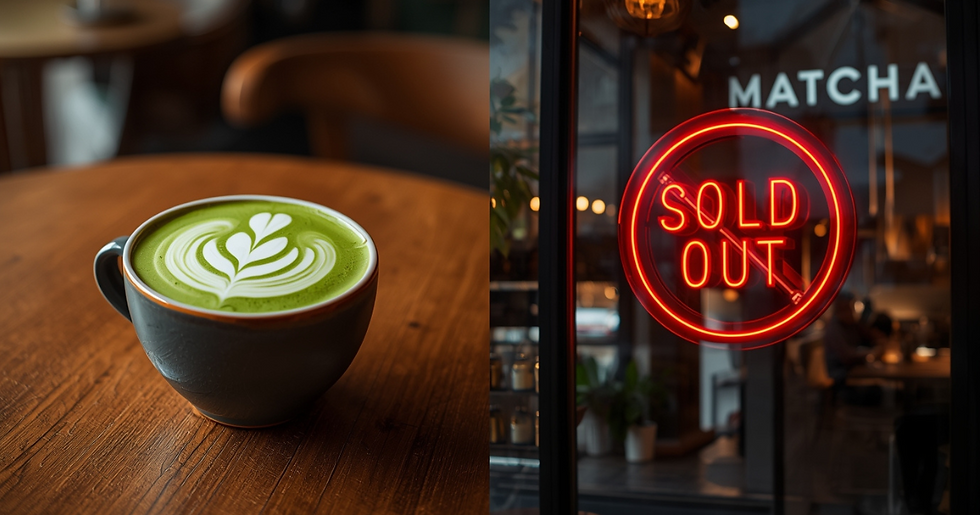What Matcha Does Starbucks Really Use?
- taha611
- Jul 25
- 3 min read
If you've ever wondered what matcha Starbucks uses in their popular green tea lattes, the answer might surprise you. Despite Starbucks' role in popularizing matcha worldwide, what they serve isn't authentic Japanese matcha. Instead, it's a sugar-heavy powder blend that contains only a small portion of actual green tea.
For café owners, distributors, and wellness brands sourcing matcha ingredients, understanding this difference is crucial for making informed purchasing decisions.

Starbucks Matcha Ingredients: The Shocking Truth
According to Starbucks' official ingredient list, their matcha powder contains:
"Matcha Powder (Sugar, Ground Japanese Green Tea)"
This reveals several concerning facts:
The powder is approximately 50-80% sugar
Ground green tea makes up only a small portion
No transparency about the tea origin, processing, or grade
Lacks the stone-milled texture and umami depth of real matcha
Authentic Japanese matcha is never pre-mixed with sugar or processed with industrial shortcuts.
What Makes Authentic Japanese Matcha Different from Starbucks Matcha?
Real Japanese matcha follows centuries-old production methods:
Shade-Growing Process: Tea plants are covered for 3-4 weeks before harvest, increasing chlorophyll and creating matcha's signature vibrant green color.
Stone-Milling Tradition: Granite mills grind dried tea leaves at slow speeds to prevent heat damage and preserve nutrients.
Premium Origins: True matcha comes from renowned Japanese regions
Matcha Grades Explained
Ceremonial Grade: Highest quality for traditional tea ceremonies and drinking straight.
Premium Grade: Excellent for lattes and smoothies with balanced flavor.
Culinary Grade: Designed for cooking and baking with a stronger flavor.
Why Starbucks Matcha Isn't Real Japanese Matcha
Sugar Content Issues
Traditional matcha contains zero added sugar. Natural sweetness comes from amino acids like L-theanine developed during shade-growing. Starbucks' sugar blend masks natural flavors and eliminates health benefits.
Processing Standards
Authentic matcha follows strict Japanese quality standards, including specific grinding methods and freshness protocols. Mass-produced blends don't meet these traditional requirements.
Lack of Transparency
Legitimate suppliers provide detailed origin, harvest dates, and processing information. Starbucks offers no such transparency about its green tea component.
Health Comparison: Starbucks Matcha vs Real Matcha
Starbucks Matcha | Authentic Matcha |
High sugar (15-20g per serving) | Zero added sugar |
Reduced antioxidants due to dilution | High catechins and EGCG |
Added calories from sugar | Rich in L-theanine |
Minimal amino acid content | High nutrient density |
The health benefits associated with matcha—sustained energy, antioxidants, metabolism support—are significantly reduced in sugar-diluted versions.
Complete Comparison Table
Feature | Starbucks "Matcha" | Authentic Japanese Matcha |
Sugar Content | 50-80% sugar | 0% added sugar |
Origin | Limited Transparency | Specific Japan Regions |
Processing | Industrial Grinding | Stone-Mill |
Color | Pale Green | Vibrant Jade Green |
Flavor | Sweet, Artificial | Complex Umami, Natural Sweetness |
Grade | Unspecificied | Ceremonial or Culinary |
Best Use | Sweet Beverages or Desserts | Tea Ceremony, Lattes, and Culinary |
What to Look for When Buying Matcha
For Businesses:
Direct Japan sourcing
Multiple grade options for different applications
Organic certification for premium positioning
Bulk availability with consistent quality
Quality Indicators:
Vibrant green color (not yellowish)
Fine powder texture
Fresh, grassy aroma
Specific origin information
Proper packaging (light-proof containers or pouches)
Frequently Asked Questions
Is Starbucks matcha healthy?
Starbucks matcha contains high added sugar, significantly reducing health benefits compared to pure matcha. It's more of a dessert drink than a health beverage.
How much caffeine is in Starbucks matcha?
Approximately 55-80mg, depending on size, similar to green tea but with reduced L-theanine content compared to pure matcha.
What grade of matcha does Starbucks use?
Starbucks doesn't specify the grade. Given mass production requirements, it's likely lower culinary grade or tea dust rather than premium matcha.
Why is Starbucks matcha so sweet?
Sugar is the primary ingredient (50-80% of the powder), designed to appeal to Western palates unfamiliar with matcha's natural umami flavor.
Can I use Starbucks matcha for baking?
Not ideal due to high sugar content, which affects recipe balance. Pure culinary-grade matcha provides better flavor control.
The Bottom Line: Choose Authenticity
While Starbucks introduced many consumers to matcha-flavored beverages, their product represents a Westernized interpretation rather than traditional Japanese matcha. For businesses serious about offering genuine matcha experiences, sourcing authentic Japanese matcha ensures better profit margins, customer satisfaction, and the ability to educate consumers about real tea culture.
The investment in real matcha pays dividends through premium positioning, repeat customers, and authentic health benefits that customers increasingly seek.
Ready to source authentic Japanese matcha for your business? Contact Omakase Japan at info@omakasejp.com for more information on buying organic or conventional Matcha in bulk for wholesale directly from Japan. We offer Matcha in Bulk with an MOQ of 10kgs, or you can purchase our pure organic Matcha in bulk in 30g packages


Comments